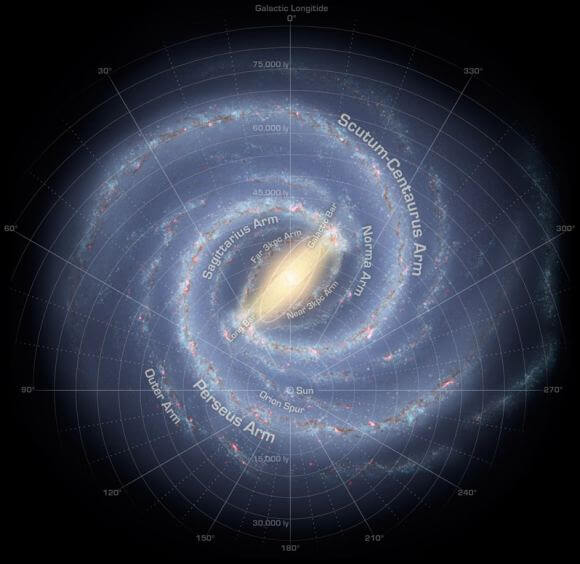
Despite a century of research and observation, our knowledge of our own milky Way galaxy still contain a lot of gaps. To date, if you think about it, we more or less figured out its estimated diameter is of the order of 100-180 thousand light years, and the estimated number of stars that can be from 100 to 400 billion. At the same time, in recent decades, astronomers are very interested in the evolutionary history of our galaxy.
For example, scientists have long been looking for an answer to the question, where did the halo of our galaxy – a giant structure of stars, dark matter and gas surrounding the galactic disk of the milky Way at the top and bottom. According to earlier assumptions, this halo could have formed from the remnants of smaller galaxies that have merged or were absorbed by the Milky Way. However, the results of a new study conducted by an international team of astronomers, indicate that in it the stars could be born inside the milky Way, and then had him thrown out.
On their findings, the team of scientists at the Australian national University, the California Institute of technology, and a number of other educational and scientific institutions and working under the direction Margie Bergmann from the Institute of astronomy of max Planck society, shared in the journal Nature.

The artistic representation of the milky Way galaxy
In their study, the astronomers relied on data collected by the Hawaiian Keck Observatory, which scientists have found the chemical composition of 14 stars located within the galactic halo. These stars are situated in two different parts of the halo stellar superclusters Tri-and A13, each of which is about 14 thousand light-years above and below the plane of the galactic disk of the milky Way.
“Analysis of chemical composition – a very serious study that allows for an analogy with DNA to determine the relationship of stars and their source population. Different initial populations such as the galactic disk of the milky Way or its halo, dwarf galaxies or globular clusters, all of them have different chemical composition. So as soon as we can figure out what stars are made, we will be able to immediately build a connection between them and their original populations,” commented Bergman in the published press release of the Observatory Keck.
As a secondary data source of the spectra, the researchers used the Very large telescope (VLT) the European southern Observatory in Chile. Comparing the chemical composition of the investigated stars with those which were discovered inside other cosmic structures, the scientists noted that their chemical compositions were almost identical. They were similar not only between itself and other studied groups, but also closely match the composition of stars, found in the outer disk of the milky Way.

A computer model of the milky Way and its compact neighbor, the dwarf galaxy Sagittarius
On this basis, scientists have concluded that the stellar population in the galactic halo was originally formed in the milky Way, but then migrated into the space above and below the galactic disk. This phenomenon is called “galactic eviction”. It is due to the fact that stars can be ejected other rather massive dwarf galaxies, which passed through the milky Way in the past.

Modeling perturbations caused by the gravitational interaction with the milky Way close to the dwarf galaxy. Shown stars in the halo, the position of which was taken into account when testing models
“They ejected from the plane of the milky Way, when it passes through a fairly massive dwarf galaxy. This passage creates oscillations, perturbations, out of which the stars of the disc, up or down, depending on the direction of movement of the indignant masses,” explains one of the authors Judy Cohen.

360-degree panorama of the milky Way (consists of many photos)
This discovery is interesting for two reasons. On the one hand, it testifies in favor of the assumption that the stars are in the galactic halo, initially appear inside the galactic disks, and then can be thrown away beyond them. On the other – shows that the galactic disk of the milky Way and its dynamics are far more complex phenomenon than previously thought.
“We have proved that the situation with the resettlement of stars at greater distances from their original locations due to satellite galaxies is a very common phenomenon. At least in the realities of the milky Way. It is possible that similar features related to the chemical composition of stars, there may be other galaxies, which in turn will testify to the universality of such galactic dynamic processes,” adds Allison Sheffield, an astronomer at the Community College LaGuardia.
Next, the astronomers plan to conduct spectral analysis of additional stars from Sverdrup Tri-and A13, and explore star clusters, which are located further away from the galactic disk. In addition, the researchers would like to identify the mass and age of these stars. Based on these data, the researchers could make the assumption of when it happened is galactic eviction.
Such studies will enable us more accurately to understand the evolution of galaxies. And in combination with the ongoing efforts of scientists to study the cores of galaxies, and the search for connection between supermassive black holes and star formation we are gradually approaching a full understanding of how our universe evolved to the state where she is now.
Scientists have found where the stars in the halo of the milky Way
Nikolai Khizhnyak